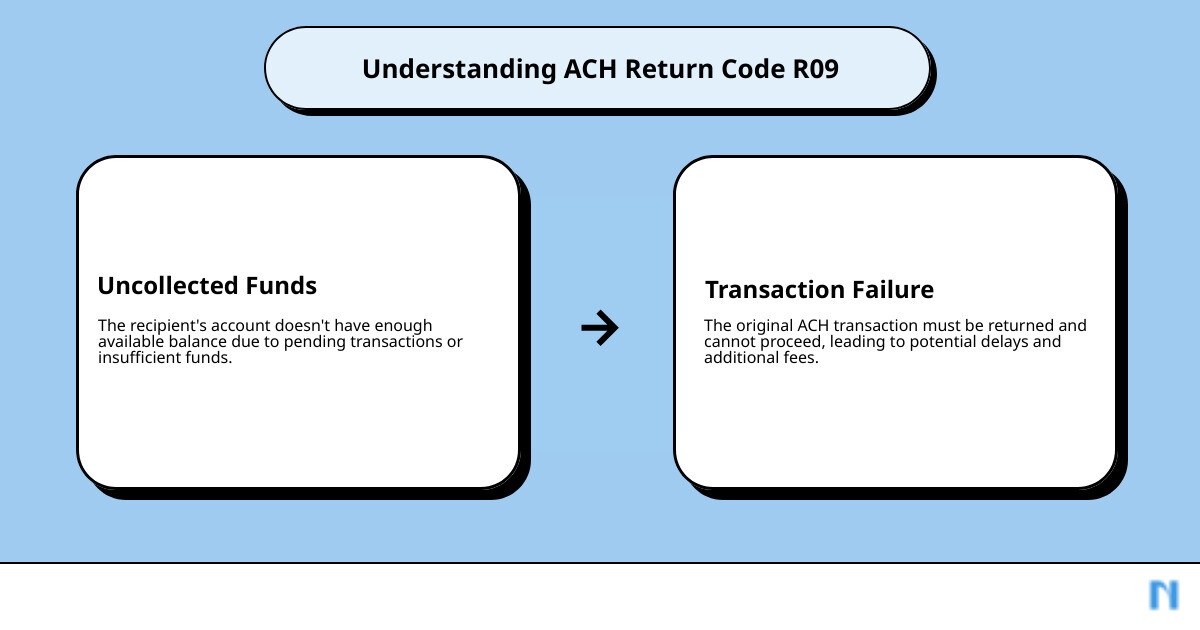Categories: ACH Payments
ACH Return Code R09: What It Means and How to Handle It
ACH Return Code R09: Top 3 Critical Facts in 2024
Understanding ACH Return Code R09
When dealing with Automated Clearing House (ACH) payments, financial institutions often encounter return codes. One critical code to understand is ACH Return Code R09. This code, defined by NACHA (National Automated Clearing House Association), signifies that the recipient’s account lacks enough available funds for successful transaction processing.
Key points about ACH Return Code R09:
- Definition: Indicates “Uncollected Funds” due to insufficient available balance.
- Common Scenario: Insufficient funds to cover pending transactions.
- Implications: The original transaction must be returned and cannot proceed.
ACH return codes like R09 play a significant role by simplifying the identification and communication of payment failures between originating and receiving financial institutions. For a financial institution managing numerous transactions, understanding these codes reduces errors and improves cash flow and client relations.
By grasping what ACH Return Code R09 means and learning how to handle it, financial institutions can better steer payment rejections and maintain smoother operations.

What is ACH Return Code R09?
Definition of ACH Return Code R09
ACH Return Code R09, also known as “Uncollected Funds,” is a standard code used in ACH transactions. It indicates that a debit entry was returned because the receiver’s account did not have enough available funds to cover the transaction.
When a bank tries to process an ACH payment, it checks if the account has sufficient funds. If not, the transaction is flagged with ACH Return Code R09. This code essentially means that while the account may have funds, they are not available due to pending transactions or holds.
The National Automated Clearing House Association (NACHA) sets the rules for handling these return codes. According to NACHA, the receiving bank must return the transaction with code R09 within two banking days.
Common Scenarios for ACH Return Code R09
Insufficient Funds: This is the most common reason for an R09 return code. The account holder might have written checks or scheduled other payments that haven’t cleared yet, making the funds unavailable for the ACH transaction.
Pending Transactions: Sometimes, the account may appear to have enough funds, but pending transactions like checks or other debits reduce the available balance. For example, if a customer has a $500 balance but $400 in pending transactions, only $100 is available for new transactions.
Account Balance: Monitoring the account balance is crucial. Customers often overlook their pending transactions, leading to an R09 return code. Regularly checking the balance can help avoid this issue.

Understanding these scenarios can help both businesses and individuals manage their finances better and reduce the occurrence of uncollected funds.
Next, we will explore how to handle ACH Return Code R09 effectively.
How to Handle ACH Return Code R09
Steps to Resolve ACH Return Code R09
When you encounter ACH Return Code R09, it means the account has insufficient available funds. Here’s how you can resolve it:
-
Retry Transaction: Sometimes, the simplest solution is to wait and retry the transaction later. Funds might become available after pending transactions clear.
-
Contact Customer: Reach out to the customer and explain the issue. They might not be aware of their pending transactions. Ask them to add funds to their account.
-
Wait for Funds: If the customer expects incoming funds, you might need to wait a few days before retrying the payment. However, this isn’t always the best approach for timely payments.
-
Fund Transfer: Suggest the customer transfers funds from another account to cover the transaction. This can be a quick fix if they have multiple accounts.
Best Practices for Avoiding ACH Return Code R09
Preventing ACH Return Code R09 can save time and hassle. Here are some best practices:
-
Account Monitoring: Encourage customers to regularly monitor their account balances and pending transactions. This helps them stay aware of available funds.
-
Customer Education: Inform customers about the importance of maintaining sufficient available funds. They should know that pending transactions affect their balance.
-
Payment Scheduling: Set up payment schedules that align with the customer’s payday or when they usually have funds available. This reduces the chances of uncollected funds.
By following these steps and best practices, you can effectively handle and minimize the occurrence of ACH Return Code R09.
Next, we’ll address some frequently asked questions about ACH Return Code R09.
Frequently Asked Questions about ACH Return Code R09
What is the R09 ACH code?
The R09 ACH code stands for “Uncollected Funds.” It means that while the account may have the necessary funds, those funds are not available at the time of the transaction. This could be because of pending checks or other transactions that have not yet cleared.
What is banking code R09?
The banking code R09 is used in ACH transactions to indicate uncollected funds. It’s a standard code maintained by NACHA, the governing body for ACH transactions. This code helps financial institutions communicate why a payment was returned.
What is a R09 reject code?
A R09 reject code means that there are uncollected funds in the account. Even if the account has a sufficient balance, pending transactions can make the available balance insufficient to cover the ACH debit. This results in the bank rejecting the transaction and returning it with an R09 code.
By understanding these aspects of ACH Return Code R09, you can better steer the challenges it presents. This knowledge helps in addressing and preventing issues effectively.
Next, we’ll explore the consequences of ACH Return Code R09 for both merchants and customers.
Consequences of ACH Return Code R09
Impact on Merchants
Return Fees: One immediate consequence for merchants is the incurrence of return fees. Each returned transaction typically comes with a fee charged by the bank, adding to operational costs.
Compliance Issues: Merchants must also comply with NACHA rules, which mandate timely handling of return codes. Failure to do so can result in penalties and additional scrutiny from financial regulators.
Customer Relationship: Repeated issues with uncollected funds can strain relationships with customers. It may create trust issues and lead to dissatisfaction, impacting long-term business relationships.
Retry Limits: NACHA rules often limit the number of times a transaction can be retried. Merchants need to be aware of these limits to avoid further penalties and ensure compliance.
Customer Communication: Effective communication with customers is crucial. Merchants should promptly inform customers about the returned transaction and work together to resolve the issue, whether it’s updating account information or waiting for funds to become available.
Impact on Customers
Payment Delays: For customers, an ACH return code R09 can result in significant payment delays. This can disrupt their financial planning and lead to further complications, such as missed deadlines for payments.
Account Monitoring: Customers need to closely monitor their account balances and pending transactions. Ensuring that there are sufficient funds available to cover ACH debits is essential to avoid returns.
Fund Availability: Customers might not always be aware of pending transactions that reduce their available balance. Educating them about this can help prevent future occurrences of return codes.
By understanding the consequences of ACH Return Code R09, both merchants and customers can take proactive steps to mitigate the impact and ensure smoother financial transactions in the future.
Conclusion
ACH payments are a powerful tool for businesses, offering a low-cost, efficient alternative to credit card transactions. However, understanding ACH return codes is crucial for managing payment failures and maintaining smooth financial operations.
ACH Return Code R09, which indicates uncollected funds, is one of the most common return codes that businesses encounter. Knowing how to handle this code can save time, reduce costs, and improve customer relationships.
To address R09 returns effectively:
- Communicate with Customers: Reach out to customers to inform them about the returned transaction and request that they ensure sufficient funds are available.
- Retry the Transaction: After confirming fund availability, retry the ACH debit.
- Educate Customers: Help customers understand the importance of monitoring their account balances and pending transactions.
By following these steps and implementing best practices such as regular account monitoring and clear payment scheduling, businesses can minimize the occurrence of ACH return codes.
At ACH Genie, we provide tools and resources to help you steer the complexities of ACH payments. Our solutions ensure accurate processing and reduce the likelihood of payment rejections.
For more information on how ACH Genie can streamline your payment operations, visit our ACH payments page.
Understanding and addressing ACH return codes like R09 is essential for smooth financial transactions. With the right strategies and tools, businesses can handle these challenges effectively and maintain robust financial health.